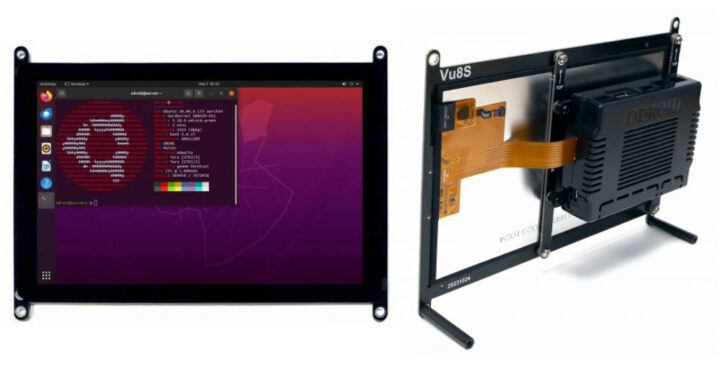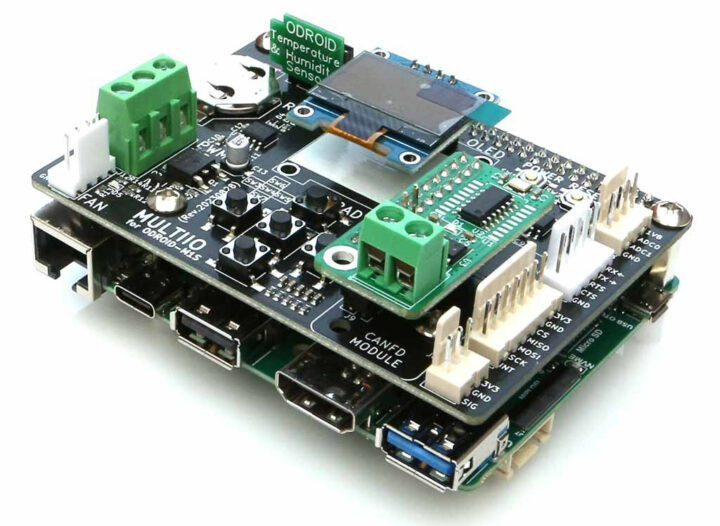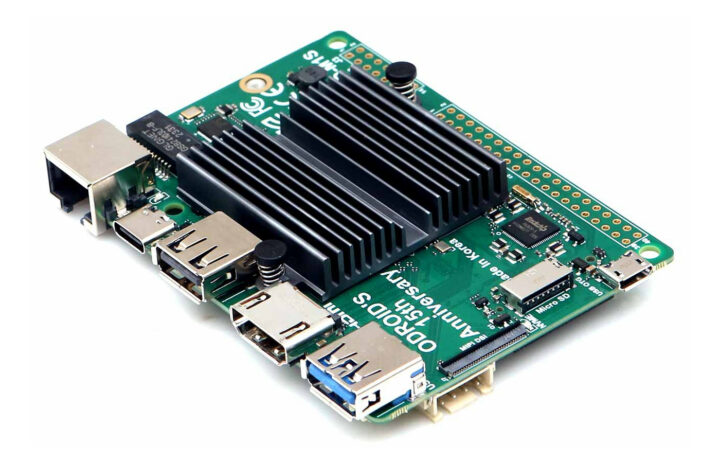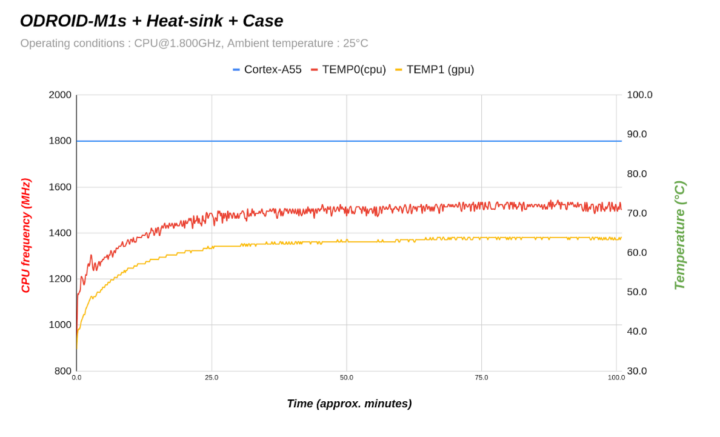Designed for Hardkernel’s 15th anniversary, the ODROID-M1S is a smaller, cheaper ($49 and up), and more efficient single computer board compared to the ODROID-M1 single board computer introduced last year with a Rockchip RK3568 SoC.
The new ODROID-M1S SBC features a Rockchip RK3566 SoC which is similar to the RK3568, but with fewer peripheral interfaces, 4GB or 8GB LPDDR4 memory, a 64GB eMMC flash solder on the board (instead of an eMMC flash connector), HDMI 2.0 and MIPI DSI video interfaces, gigabit Ethernet, a few USB ports, and two GPIO headers. It does lose a few features compared to the ODROID-M1, as its memory is clocked at a lower speed, the M.2 socket only supports PCIe 2.1, the SPI flash and SATA port are gone, and so is the MIPI CSI camera connector. The power supply has also changed from a 12V DC jack to a 5V USB-C port.
ODROID-M1S specifications with highlights in bold or strikethrough showing the difference against ODROID-M1:
- SoC – Rockchip RK3566 quad-core Cortex-A55 processor @ up to 1.8 GHz with Arm Mali-G52 MP2 GPU @ 800 MHz, 0.8 TOPS AI accelerator
- System Memory – 4GB or 8GB LPDDR4 RAM at 2112 MT/s or up to 1,055 MHz
- Storage
16MB SPI flash- 64GB eMMC flash (soldered on PCB) benchmarked at up to 180MB/s with fio
- MicroSD card slot (UHS-I SDR104, boot priority higher than eMMC flash)
- M.2 NVMe M-Key 2280 socket (1-lane PCIe 2.1) benchmarked at up to 400MB/s with fio (Note: ODROID-M1 could support 1,600MB/s thanks to PCIe 3.0)
Native SATA 3.0 port + SATA power (5V only) tested up to around 500 MB/s
- Video Output
- 1x HDMI 2.0 port up to 4Kp60 with HDR, EDID
- 4-lane MIPI DSI connector (30-pin, while ODROID M1 has a 31-pin connector)
Camera I/F – 1x 2-lame MIPI CSI connector- Audio – 3.5mm headphone jack, mono speaker output (1.3W at 8Ω load)
- Networking – Gigabit Ethernet RJ45 port via Realtek RTL8211F Ethernet transceiver
- USB
- 1x USB 3.0 port
- 1x USB 2.0 port
- 1x Micro USB 2.0 OTG port
- Expansion – 40-pin GPIO header + 14-pin GPIO header (both headers optional)
- Debugging – UART header for serial console
- Misc –
Power button,SPI Boot Select switch, IR receiver, RTC batteryholderconnector,jumper, 2x system LEDs, M.2 LED - Power Supply – 5V/3A via USB Type-C port
- Power consumption
- Power off – 0 Watt
- Idle – 1.1 Watt (vs 1.3 Watt)
- CPU stress – 3.52 Watts with performance governor (vs 4.5 Watts)
- Dimensions – 90 x 65 x 16mm (ODROID-M1: 123 x 100 x 19mm with heatsink)
- Weight – 52 grams with heatsink

Since Rockchip RK3566 and RK3568 are mostly software compatible, the new ODROID-M1S SBC can leverage existing support for the ODROID-M1, and Hardkernel provides Ubuntu 20.04 LTS with Linux 5.10.160, Ubuntu 22.04 LTS with Linux 6.1.60 (and open-source Panfrost driver for the Mali GPU), Android 11 (AOSP) images for the board. People who are used to controlling GPIOs on a Raspberry Pi using the WiringPi library may be interested to know the library is also present in the Ubuntu images for the ODROID-M1S. There’s also a detailed wiki explaining how to get started, use the board with Ubuntu or Ubuntu, and build the images from scratch.
Performance is close to the one of the ODROID-M1, but in some cases, the ODROID-M1S is a bit slower (e.g. AI benchmark running on the NPU) due to the lower memory bandwidth. The company also measured the CPU temperature underload with RK3566 SBC fitted with its heatsink and housed in the plastic case, and the temperature never exceeded 75°C under load in a room at 25°C, so no fan is needed to operate the board at its maximum performance.
Hardkernel made the changes based on customers’ feedback since they requested a lower price, more GPIO ports, lower power consumption, a slimmer form factor, and a variety of practical peripherals. We’ve already (mostly) addressed the first three in this post, so here’s a list of the peripherals available for the ODROID-M1S:
- ODROID-M1S plastic enclosure
- ODROID-Vu8S (8-inch) and upcoming ODROID-Vu5S (5-inch) capacitive touchscreen displays
- UPS kit for ODROID-M1S taking on 18650 battery
- Mini IO board using the new 14-pin GPIO header to expose USB 2.0 host, Power button, Reset button, Audio line-out 3.5mm phone jack and I2C & UART buses.
- 4-Channel Relay Board
- 6-Channel Stepper Motor Controller Board
- Multi I/O Training Board using both 40-pin and 14-pin GPIO headers with an OLED display, a 5-key keypad, a CAN FD interface, a 3-pin terminal block for power, an RTC battery holder, and extra connectors for ADC, RS232, SPI, and GPIOs.
- Speaker kit with two speakers connected to the 14-pin GPIO header using a small PCB
- CAN FD add-on board with 2-pole terminal block to be used with the Multi IO Training Board or directly on 40-pin GPIO board (TBD)
- Weather Zero board (humidity and temperature sensor)
- Barrel to USB Type-C adapter to connect 8V-17V power supply with a DC jack (5.5/2.1mm)


Four variants of the ODROID-M1S are currently available:
- $49 with 4GB RAM, heatsink, case, and power supply
- $52 with 4GB RAM, heatsink, case, power supply, and pre-soldered GPIO headers
- $59 with 8GB RAM, heatsink, case, and power supply
- $62 with 8GB RAM, heatsink, case, power supply, and pre-soldered GPIO headers
You’ll find Hardkernel’s latest Rockchip RK3566 single board computer on the company’s online store. We are told the boards and accessories will be shipped within a few days, but at the same time, the company will be hosting a “Debug Party” by shipping “engineering sample boards and a few selected accessories in a couple of days to our community members”. If you are risk-averse, you may want to wait for a few weeks before going ahead with a purchase. As I wrote this post, Hardkernel contacted us about getting a sample and a few accessories, so there may be a review on CNX Software in a few weeks as well…
Thanks to Tim for the tip.

Jean-Luc started CNX Software in 2010 as a part-time endeavor, before quitting his job as a software engineering manager, and starting to write daily news, and reviews full time later in 2011.
Support CNX Software! Donate via cryptocurrencies, become a Patron on Patreon, or purchase goods on Amazon or Aliexpress







